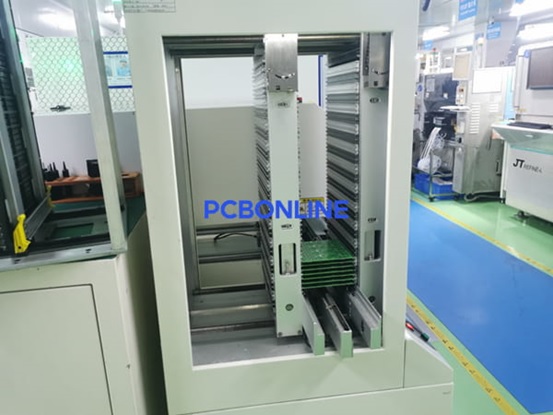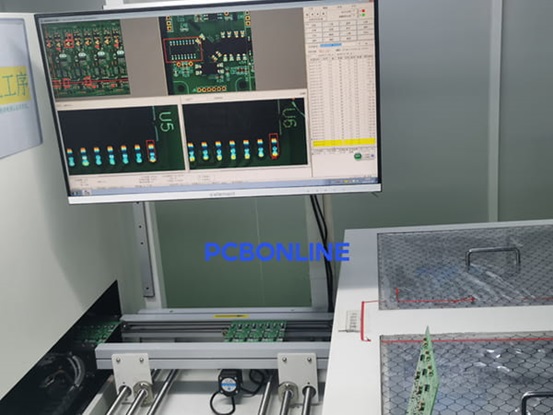Electronic assembly is the process of combining electronic components to create a functional electronic device. This process is essential for the manufacturing of many products such as computers and modules such as ESP32.
In order to achieve a successful electronic assembly, it is important to work with an experienced and reliable EMS (Electronics Manufacturing Services) PCBA (Printed Circuit Board Assembly) manufacturer such as PCBONLINE.
Electronic assembly process
Broadly speaking, electronic assembly involves designing and fabricating a printed circuit board (PCB), component sourcing, PCB assembly, and box build assembly. Narrowly speaking, electronic assembly only refers to PCB assembly.
From an EMS PCBA manufacturer like PCBONLINE, electronic assembly for electronic manufacturing is automatic, and its process can be sectioned into the below steps:
Printing solder paste on PCB:

On an SMT line, all the machines are connected and pre-programmed to specific specifications for the PCBs to be assembled. A feeder sends the blank PCBs one by one to a solder paste printing machine, in which the solder paste is pressed to go through openings of an SMT stencil to print on the pads of the PCB.
Solder paste inspection (SPI):
After solder paste printing, the PCB goes under the infrared cameras of an SPI machine. The SPI machine compares the scanned images with the reference to make sure the sizes, positions, and thickness of the solder paste are adequate for soldering.
Placing SMDs on PCB:
In the component mounting machines, SMDs (surface-mount devices) are picked and placed on the pads of the PCB. The two machines are a high-speed mounting machine and a functional mounting machine. The former places smaller SMDs such as resistors and capacitors, while the latter places larger SMDs such as ICs and connectors.
Reflow soldering:
In a reflow soldering oven, the PCBAs are preheated and baked, and the solder melts on the PCB copper pads to form an intermetallic compound (IMC). The emergency of IMC means successful soldering. The temperatures of reflow temperatures follow the reflow profile set up by the PCB assembly manufacturer.
Automatic optical inspection (AOI)

At PCBONLINE, the AOI inspection is in line. The PCBAs go through the AOI machine one by one. The machine scans the four sides and top of the PCBAs and compares them with the reference to make sure the surface of the PCBA is qualified. The AOI can check out many soldering defects, such as bridges, tombstones, open circuits, solder voids, etc.
Later, if needed, the PCBA undergoes through-hole assembly. After PCB assembly, PCBONLINE can have all the EMS value-added services to the assemblies, including PCBA functional testing, IC programming, thermal aging, conformal coating, and box-build assembly.
Advantages of Working with an EMS PCBA Manufacturer:
An EMS PCBA manufacturer provides one-stop electronic assembly and flexible electronics production. By working with an EMS PCBA manufacturer like PCBONLINE, you can enjoy many advantages. Here are 5 Reasons to Work with an EMS PCBA Manufacturer.
Cost savings:
One of the primary advantages of working with an EMS PCBA manufacturer such as PCBONLINE is cost savings. By outsourcing the electronic assembly process, companies and business makers can save on the cost of equipment, labor, and overhead. PCBONLINE has a team of 100+ experienced engineers and 500+ technicians who are able to produce high-quality PCBAs efficiently and cost-effectively.
Time savings:
Another advantage of working with an EMS PCBA manufacturer is time savings. PCBONLINE has a streamlined process for electronic assembly that allows for fast turnaround times. For small expedited PCBA prototypes, PCBONLINE can adopt the two-shift work model to finish the work without quality sacrifice. This can be particularly important for companies that need to get their products to market quickly.
Quality control:
PCBONLINE has a rigorous process to ensure that each PCBA meets the required specifications. This includes testing and inspection at every stage of the production process. And its two large, advanced PCB manufacturing bases and one PCB assembly factory follow the ISO quality system. By working with an EMS PCBA manufacturer with a strong commitment to quality control, companies can be confident that their electronic devices will perform as intended.
Design assistance:
PCBONLINE has a team of engineers who can provide one-on-one engineering support and design assistance to ensure the PCBA meets the required specifications. This includes optimizing the layout of the components, selecting the appropriate materials, and testing the PCBA to ensure that it meets the required performance standards.
Flexibility:
PCBONLINE can handle both small and large production runs, providing flexibility to meet the needs of different companies and business makers. This can be particularly important for companies that need to scale production up or down depending on demand.
Conclusion:
Electronic assembly is a complex process that requires expertise and attention to detail. By working with an experienced and reliable EMS PCBA manufacturer such as PCBONLINE, companies can benefit from cost and time savings, quality control, design assistance, and flexibility. With these advantages, companies can be confident in the reliability and performance of their electronic devices and focus on other aspects of their business.


Hi,
Good knowledge article.
Keep it up.